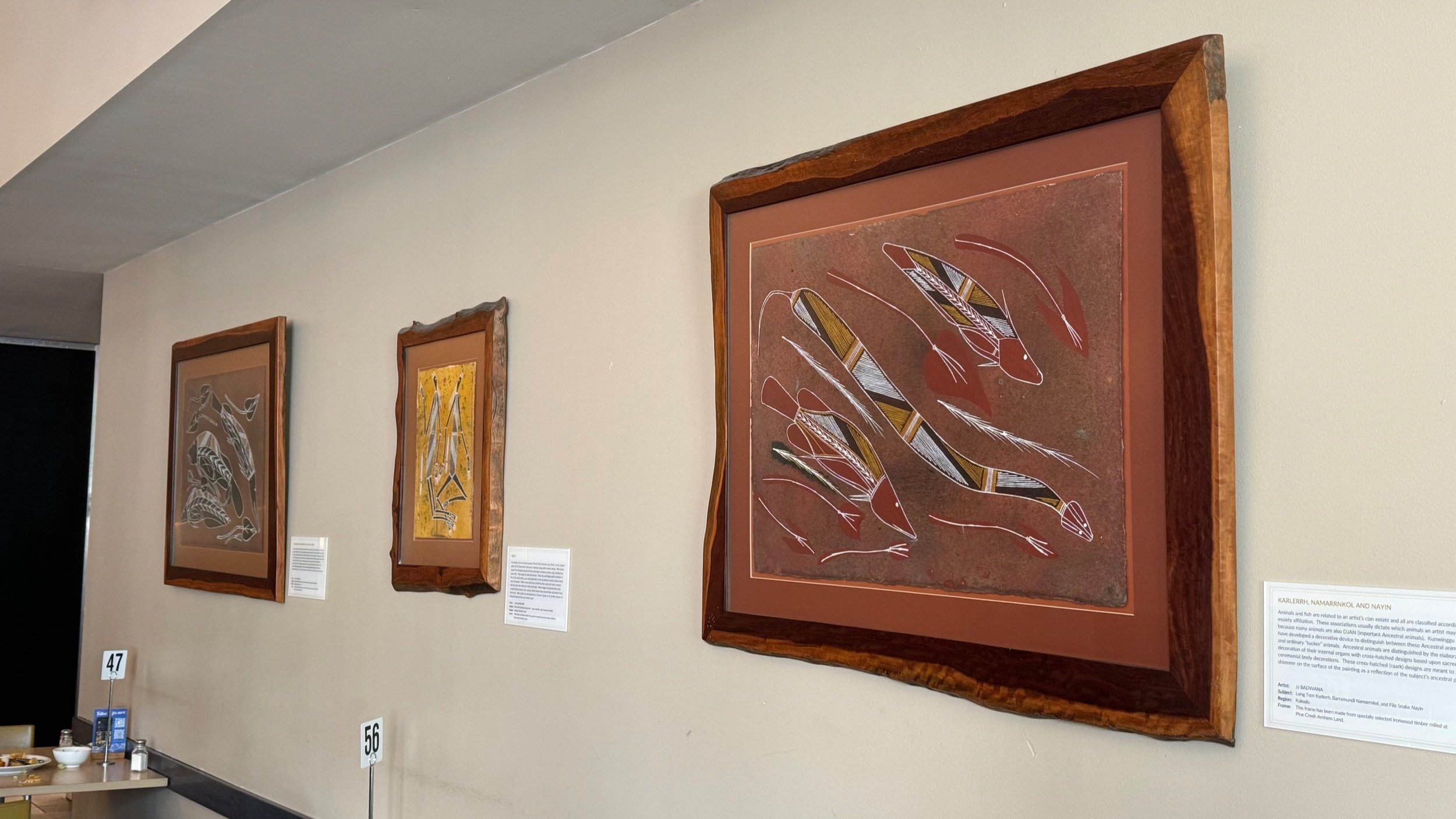
Indigenous Artwork
Indigenous Artwork at the Hellenic Club
The Hellenic and Indigenous cultures share remarkable similarities that illuminate the richness and diversity of human civilisation. Both cultures, rooted in ancient traditions, embody a deep connection to the land, a reverence for nature, and a profound respect for ancestors and spiritual beliefs. Through their unique folklore, art, music, and rituals, the Hellenic and Indigenous peoples celebrate their heritage, fostering a sense of community, harmony, and continuity with the past. Despite originating from different corners of the world, these cultures exemplify the enduring universality of human experience and the enduring power of cultural heritage to shape identities and foster understanding.
FRESHWATER LIFE
Animals and fish are related to an artist’s clan estate and all are classified according to moiety affiliation. These associations usually dictate which animals an artist may paint because many animals are also DJAN (important Ancestral animals). Kunwinggu artists have developed a decorative device to distinguish between these Ancestral animals and ordinary “tucker” animals. Ancestral animals are distinguished by the elaborate decoration of their internal organs with cross-hatched designs based upon sacred ceremonial body decorations. These cross-hatched (raark) designs are meant to shimmer on the surface of the painting as a reflection of the subject’s ancestral power.
Artist: Mark DJANDJOMERR
Subject: Saltwater Crocodile Kinga, Barramundi Namarrnkol, and Saratoga (fish) Kuluybirr
Region: Kakadu National Park /Arnhem Land
Frame: This frame has been made from specially selected Ironwood timber milled at Pine Creek Arnhem Land.
KARLERRH, NAMARRNKOL AND KULUYBIRR
Animals and fish are related to an artist’s clan estate and all are classified according to moiety affiliation. These associations usually dictate which animals an artist may paint because many animals are also DJAN (important Ancestral animals). Kunwinggu artists have developed a decorative device to distinguish between these Ancestral animals and ordinary “tucker” animals. Ancestral animals are distinguished by the elaborate decoration of their internal organs with cross-hatched designs based upon sacred ceremonial body decorations. These cross-hatched (raark) designs are meant to shimmer on the surface of the painting as a reflection of the subject’s ancestral power.
Artist: Joshua BANGARR
Subject: Long Tom Karlerrh, Barramundi Namarrnkol, and Saratoga (fish) Kuluybirr
Region: Kakadu /Arnhem Land
Frame: This frame has been made from specially selected Ironwood timber milled at Pine Creek Arnhem Land.
SACRED BILLABONG
Yawk Yawk are female Water Spirits who have lived in the sacred waterholes of Mariwon country in Western Arnhem Land since the time of Creation. These Spirits leave their waterholes deep in the escarpment country to collect food on land. When no one is looking their tails turn into legs so they can climb onto the rocks and laze in the sun sometimes they transform themselves into dragonflies. If you disturb a Yawk Yawk Spirit she will catch you and drag you under the water for eternity.
Artist: Gersham GANGARR
Subject: Freshwater Crocodile Kumuken, Barramundi Namarrnkol, Saratoga (fish) Kuluybirr, Mermaid Spirit Yawk Yawk and Goanna Kalawan
Region: Arnhem Land
Frame: This frame has been made from specially selected Ironwood timber milled at Pine Creek Arnhem Land.
MIMI
According to the Kunwinjku people of North West Arnhem Land, Mimi’s are the original spirits of the Dreamtime that were in existence long before human beings. Mimi Spirits taught the Aboriginal people all they know about ceremony, dance, song, hunting and bush skills. They made the land and the law. These shy and fragile spirits continue to live in the rocks, trees, caves, and waterholes in the escarpment country and are rarely seen by humans. Mimi’s were said to be so frail that they could not hunt or venture into the open land when the winds were high. When danger threatened them they would slip into narrow rock crevices which would close around them and protect them from harm. Mimi spirits are also depicted as Dynamic Figures in the prolific rock art of Kakadu National Park and Arnhem Land.
Artist: Joshua BANGARR
Subject: Mimi with hunting implements – spear mankole, spear thrower borndok
Region: Kakadu /Arnhem Land
Frame: This frame has been made from specially selected Ironwood timber milled at Pine Creek Arnhem Land.
Get social with us on Instagram.
KARLERRH, NAMARRNKOL AND NAYIN
Animals and fish are related to an artist’s clan estate and all are classified according to moiety affiliation. These associations usually dictate which animals an artist may paint because many animals are also DJAN (important Ancestral animals). Kunwinggu artists have developed a decorative device to distinguish between these Ancestral animals and ordinary “tucker” animals. Ancestral animals are distinguished by the elaborate decoration of their internal organs with cross-hatched designs based upon sacred ceremonial body decorations. These cross-hatched (raark) designs are meant to shimmer on the surface of the painting as a reflection of the subject’s ancestral power.
Artist: JJ BADWANA
Subject: Long Tom Karlerrh, Barramundi Namarrnkol, and File Snake Nayin
Region: Kakadu
Frame: This frame has been made from specially selected Ironwood timber milled at Pine Creek Arnhem Land.











